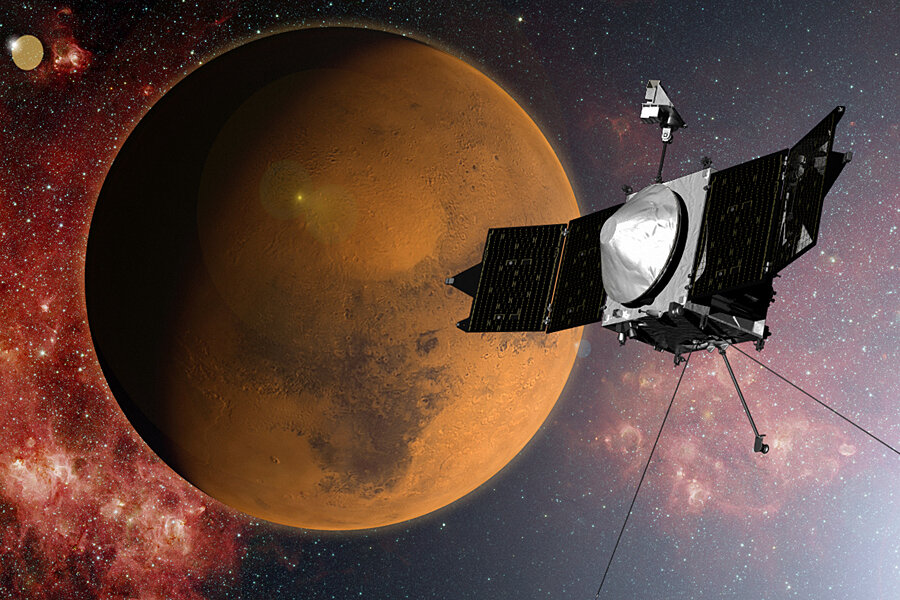Can astronauts safely go to Mars? Cosmic ray risk increasing.
Loading...
Radiation hazards during trips to the moon, Mars, or other destinations outside the protective shield of Earth's magnetic field remain one of the most daunting challenges to human exploration beyond low-Earth orbit.
The hazard from one form of radiation – galactic cosmic rays – is growing and is likely to keep growing if the sun is entering a prolonged period where sunspot activity is considerably weaker than average, as many solar physicists expect, according to a new study.
This weakening would have a profound effect on the average strength of the sun's magnetic field, the solar system's first line of defense against galactic cosmic rays. The field itself would weaken, allowing more cosmic rays to flit through the solar system and thus raising the risk they post to interplanetary astronauts.
The analysis first considered the levels of cosmic rays during the current sunspot cycle. Using the National Aeronautics and Space Administration's current radiation-exposure standards for astronauts, it found that astronauts would exceed their career radiation-dose limit in 300 to 400 days traveling beyond low-Earth orbit, depending on age and gender. A round trip to and from Mars could take from 300 to 600 days, depending on mission design.
Looking ahead to a weaker cycle with a prolonged trough, astronauts would have to make the round trip in 240 to 320 days to avoid reaching their career exposure limits.
The news isn't all bad, however.
“The upside of the study is that there also are periods of time in which radiation levels are much lower, even in this period of low solar activity,” says Nathan Schwadron, a solar physicist at the University of New Hampshire at Durham and the lead author of the study, which has just been accepted for publication in the journal Space Weather.
During these periods, the amount of time astronauts could stay in space “is significantly longer than a year,” he says.
The explanation again lies with the sun, which also is a source of energetic particles, representing another hazard to astronauts. During solar storms, vast numbers of these particles are blasted into space. On average, such storms are more numerous and intense during the peak of the sunspot cycle, when the sun's protective magnetic field is strongest.
But if overall activity is weak for a prolonged period, the peaks are weaker as well, raising the likelihood of weaker-than-usual solar storms.
“The sun right now is going into a state that we haven't seen in 100 years,” Dr. Schwadron says – a state that is consistent with the early years of the Dalton grand minimum, a period of weak solar activity that began in 1790 and lasted about 40 years, or a 30-year period beginning in 1890 that had somewhat stronger, but still weak activity.
Even the current peak in the sunspot cycle “is the wimpiest maximum we've seen in the Space Age,” he says. “It's ridiculously small.” That has carried over to relatively weak solar outbursts during this “mini maximum,” although the events “are still very dangerous,” he cautions.
As a result, during the past 10 years, the risk from cosmic rays has been increasing, with energetic particles from the sun representing the lesser of the two sources of radiation hazards – something that is easier to block with shielding.
The study is based on cosmic-ray measurements taken by an instrument aboard NASA's Lunar Reconnaissance Orbiter and NASA's Advanced Composition Explorer, which has been measuring the flow of charged particles from the sun as well as galactic cosmic rays since 1997.
It follows on the heels of measurements taken during the Mars rover Curiosity's nearly 253-day trip to the red planet between November 2011 and August 2012. In the cruise phase, Curiosity's Radiation Assessment Detector (RAD) gathered information on galactic cosmic rays and energetic particles from the sun.
In May 2013, the RAD researchers reported that between the cosmic rays and the charged particles from the sun, astronauts traveling in a craft with shielding similar to NASA's new crew exploration vehicle would either exceed or come close to exceeding their maximum allowable radiation dose during a round trip to Mars.
But while the information yielded important insights, the data only covered roughly six months of activity. The data gathered by Schwadron and 15 colleagues from NASA, several universities, and the Aerospace Corp., a federally funded R&D center in El Segundo, Calif., allowed them to analyze changes in the intensity of cosmic rays and energetic particles from the sun over longer periods of time.
The goal was to begin making some estimates of the radiation hazards that astronauts could face and how those hazards change not just within a particular solar cycle, but over cycles of different intensities.
As a first cut at the problem, the results are tentative, Schwadron cautions. Much of what researchers have learned about the frequency of solar storms, for instance, has come from observing the sun over a prolonged period when its activity was relatively high. It's crucial to get the same information during prolonged periods of weaker-than-average activity, he notes.
While dosage also depends on shielding, the radiation issue has raised questions about acceptable risks as well, Schwadron says.
“People have pointed out that maybe we have the wrong risk posture; maybe we need to accept a little more risk in terms of radiation,” he adds.








